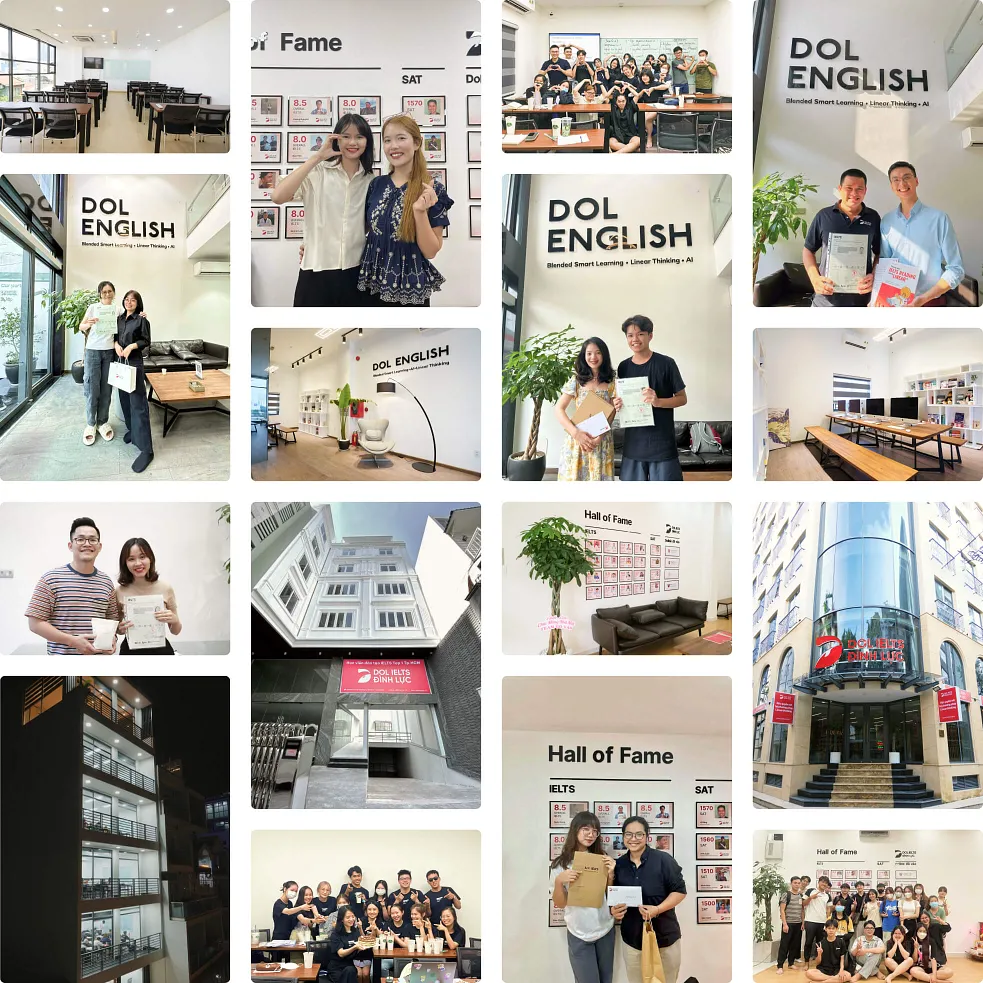Học idea và kiến thức xã hội từ bài đọc IELTS Reading
Rất nhiều bạn khi học Writing hay Speaking thường "than" là không có ý để nói, hoặc có ý thì ý cũng không hay, không được phát triển sâu mà rất chung chung, sáo rỗng. Vậy nếu muốn làm giàu nguồn ideas, nguồn kiến thức xã hội thì cần tích luỹ ở đâu? Câu trả lời cực kì đơn giản mà ít ai biết: có thể học ideas và kiến thức xã hội từ IELTS Reading. Vậy làm sao để học theo cách này hiệu quả? Hãy cùng DOL tìm hiểu qua bài viết này nhé!
DOL IELTS Đình Lực
Jun 17, 2025
2 mins read

Table of content
❓ Tại sao nên học ideas từ bài đọc?
📜 Cách học ideas từ bài đọc theo Linearthinking
Cách rút ra ideas từ bài đọc
Cách sắp xếp ideas theo mental model
📘 Cách ôn lại ideas hiệu quả theo Linearthinking
I.❓ Tại sao nên học ideas từ bài đọc?
Thông thường, những đề tài thí sinh bí ý trong Writing và Speaking thường là đề tài lạ, vĩ mô, mang tính học thuật cao (Ví dụ: những vấn đề về môi trường, về công nghệ, văn hoá…). Những vấn đề này ít khi được nhắc tới hoặc đề cập trong những bản tin đời sống hằng ngày, dẫn tới sự thiếu hụt về kiến thức xã hội trong những mảng này. Nếu như lên mạng đọc báo thì lại sợ đọc phải những thông tin chưa được xác thực hoặc chưa phù hợp về mặt ngôn ngữ.
Những bài đọc IELTS Reading chứa vốn kiến thức xã hội nhiều chủ đề. Tất cả những bài viết trong IELTS đều được trích xuất từ những bài báo (article) nước ngoài uy tín, đảm bảo và có ngôn ngữ mang tính học thuật cao, rất phù hợp để áp dụng trong Writing và Speaking.
Ví dụ: Giả sử thí sinh cần viết bài IELTS Writing về nguyên nhân gây ra nạn phá rừng nhưng không có ideas để viết thì có thể đọc ngay bài đọc sau để lấy ý:
Deforestation in the 21st century
When it comes to cutting down trees, satellite data reveals a shift from the patterns of the past.
Lí do thứ 1 của nạn phá rừng
Globally, roughly 13 million hectares of forest are destroyed each year. Such deforestation has long been driven by farmers desperate to earn a living or by loggers building new roads into pristine forest. But now new data appears to show that big, block clearings that reflect industrial deforestation have come to dominate, rather than these smaller-scale efforts that leave behind long, narrow swaths of cleared land. Geographer Ruth DeFries of Columbia University and her colleagues used satellite images to analyse tree-clearing in countries ringing the tropics, representing 98 per cent of all remaining tropical forest. Instead of the usual ‘fish bone' signature of deforestation from small-scale operations, large, chunky blocks of cleared land reveal a new motive for cutting down woods.
[...]
Lí do thứ 2 của nạn phá rừng
In other words, the increasing urbanisation of the developing world, as populations leave rural areas to concentrate in booming cities, is driving deforestation, rather than containing it. Coupled with this there is an ongoing increase in consumption in the developed world of products that have an impact on forests, whether furniture, shoe leather or chicken feed. ‘One of the really striking characteristics of this century is urbanisation and rapid urban growth in the developing world,’ DeFries says, ‘People in cities need to eat.’ ‘There’s no surprise there,’ observes Scott Poynton, executive director of the Tropical Forest Trust, a Switzerland-based organisation that helps businesses implement and manage sustainable forestry in countries such as Brazil, Congo and Indonesia. ‘It’s not about people chopping down trees. It's all the people in New York, Europe and elsewhere who want cheap products, primarily food.
Sau khi đọc bài, rút ra được 2 nguyên nhân gây ra phá rừng:
Nguyên nhân 1:
Such deforestation has long been driven by farmers desperate to earn a living or by loggers building new roads into pristine forest.
(rừng bị phá bởi nông dân và tiều phu)
Nguyên nhân 2:
People in the cities need to eat ➡ the increasing urbanisation of the developing world, as populations leave rural areas to concentrate in booming cities, is driving deforestation, rather than containing it.
(rừng bị phá để sản xuất thức ăn)
II.📜 Cách học ideas từ bài đọc theo Linearthinking
Vậy nếu muốn học ideas và kiến thức xã hội từ bài đọc IELTS Reading một cách hiệu quả thì cần học như thế nào?
🔥Cách rút ra ideas từ bài đọc
Cùng quan sát thử bài đọc sau đây và so sánh thử 2 cách rút ideas đúng và sai nhé:
Is Technology Harming our Children’s Health?
The digital revolution in music has enabled people to download, store and listen to songs on a tiny, portable device called an MP3 player. The process is quick and afterwards you can have access to a library of thousands of songs that can fit into your palm. But experts say that continuously listening to loud music on these small music players can permanently damage hair cells in the inner ear, resulting in hearing loss. For instance, old-fashioned headphones have been replaced with smaller ones that fit neatly into the ear, instead of over them, which intensifies the sound. In addition to that, digital music does not distort and keeps its crystal clear sound, even on loud settings, which encourages children to crank up the volume. Combine that with the fact that many children will spend hours listening to their iPods, and you have the recipe for hearing loss. Put into further perspective, most MP3 players can reach levels of 120 decibels, which is louder than a chainsaw or lawnmower. When you consider 85 decibels is the maximum safe decibel level set by hearing experts over the course of a working day, and that children will listen to music at higher decibel levels than that for long periods of time, hearing will invariably suffer
|
|
+ listening to music can damage hair cells + old-fashioned headphones are replaced with smaller ones which intensify the sound + digital music keeps its crystal clear sound children crank up the volume + children spend hours listening to their iPods have the recipe for hearing loss => lẻ tẻ, khó học và khó áp dụng | smaller headphones intensify the sound + digital music keeps its crystal clear sound ➡ encourage children to crank up the volume + spend hours listening to their iPods ➡ damage hair cells in the inner ear ➡ have the recipe for hearing loss => dễ nhớ, mỗi lần nhớ là nhớ luôn cả một dòng ideas |
Tuy nhiên ở ví dụ trên chúng ta chỉ mới rút ra 1 dòng ideas thôi. Lỡ như trong bài có nhiều dòng ideas thì sắp xếp chúng như thế nào?
🌟Cách sắp xếp ideas theo mental model
Để có thể nhớ tốt nhiều dòng ideas khác nhau, các dòng ideas này nên được sắp xếp dựa theo mental model (mô hình tư duy trong đầu). Các mental model thường dùng bao gồm: Advantages and disadvantages (lợi ích và bất lợi), causes - problems - solutions (nguyên nhân, vấn đề và giải pháp), time order (trình tự thời gian).
Cùng quan sát thử ví dụ sau nhé:
Traffic Jams — No End in Sight
A. There are no easy answers to the problems of traffic congestion. Traffic congestion affects people throughout the world. Traffic jams cause smog in dozens of cities across both the developed and developing world.
In the U.S., commuters spend an average of a full work week each year sitting in traffic, according to the Texas Transportation Institute. While alternative ways of getting around are available, most people still choose their cars because they are looking for convenience, comfort and privacy.
B. The most promising technique for reducing city traffic is called congestion pricing, whereby cities charge a toll to enter certain parts of town at certain times of day.
In theory, if the toll is high enough, some drivers will cancel their trips or go by bus or train. And in practice it seems to work: Singapore, London and Stockholm have reduced traffic and pollution in city centers thanks to congestion pricing.
C. Another way to reduce rush hour traffic is for employers to implement flexitime, which lets employees travel to and from work at off-peak traffic times to avoid the rush hour.
Those who have to travel during busy times can do their part by sharing cars. Employers can also allow more staff to telecommute (work from home) so as to keep more cars off the road altogether.
D. Some urban planners still believe that the best way to ease traffic congestion is to build more roads, especially roads that can take drivers around or over crowded city streets. But such techniques do not really keep cars off the road; they only accommodate more of them.
Những ideas trong bài đọc trên có thể được sắp xếp theo Mental model Causes - Problems - Solutions như sau: Traffic jam
Causes
people are looking for convenience, comfort and privacy ➡ most people still choose their cars ➡ traffic jam
Problems
Traffic congestion causes smog in dozens of cities across both the developed and developing world ➡ affects people throughout the world
Solutions
Congestion pricing ➡ Explanation: cities charge a toll to enter certain parts of town at certain times of day ➡ if the toll is high enough, some drivers will cancel their trips or go by bus or train ➡ Example: Singapore, London and Stockholm have reduced traffic and pollution in city centers thanks to congestion pricing.
Employers implement flexitime ➡ lets employees travel to and from work at off-peak traffic times to avoid the rush hour
Those who have to travel during busy times can share cars + Employers can also allow more staff to telecommute (work from home) ➡ keep more cars off the road altogether. + build more roads, especially roads that can take drivers around or over crowded city streets ➡ Antithesis: such techniques do not really keep cars off the road; they only accommodate more of them.
 Việc sắp xếp ideas theo mental model vừa dễ học, dễ nhớ lại có tính áp dụng rất cao. Ví dụ sau này gặp đề bài IELTS Writing hỏi về Causes - Problems - Solutions của Traffic jam thì học viên có thể dễ dàng có cả từ vựng và kiến thức xã hội để trả lời mà không cần suy nghĩ từng từ, từng ý nữa!
Việc sắp xếp ideas theo mental model vừa dễ học, dễ nhớ lại có tính áp dụng rất cao. Ví dụ sau này gặp đề bài IELTS Writing hỏi về Causes - Problems - Solutions của Traffic jam thì học viên có thể dễ dàng có cả từ vựng và kiến thức xã hội để trả lời mà không cần suy nghĩ từng từ, từng ý nữa!
III.📘 Cách ôn lại ideas hiệu quả theo Linearthinking
Từ mental model, để nhớ ideas hiệu quả, học viên không nên cứ đọc đi đọc lại để học thuộc lòng, mà nên kết hợp để viết đoạn hoàn chỉnh.
Ví dụ:
Solutions:
Congestion pricing ➡ Explanation: cities charge a toll to enter certain parts of town at certain times of day ➡ if the toll is high enough, some drivers will cancel their trips or go by bus or train ➡ Example: Singapore, London and Stockholm have reduced traffic and pollution in city centers thanks to congestion pricing.
Employers implement flexitime ➡ lets employees travel to and from work at off-peak traffic times to avoid the rush hour
Those who have to travel during busy times can share cars
Kết hợp thành paragraph:
There are many solutions that can be adopted to solve traffic congestion. The first method is called congestion pricing. It means that cities charge a toll to enter certain parts of town at certain times of day. If the toll is high enough, some drivers will cancel their trips or go by bus or train. Examples of this policy can be seen in Singapore, London and Stockholm - cities which have reduced traffic and pollution in city centers thanks to congestion pricing. Another method is for employers to implement flexitime. This lets employees travel to and from work at off-peak traffic times to avoid the rush hour. For those who have to travel during busy times, they can share cars to reduce traffic volume.
Qua bài viết trên, mong rằng các bạn đã hiểu được tầm quan trọng của việc học ideas và kiến thức xã hội từ IELTS Reading và cách học hiệu quả nhất sử dụng tư duy Linearthinking; để từ đó có thể áp dụng vào việc luyện thi IELTS đúng đắn nhất và đạt được band điểm cao khi thi.
Table of content
❓ Tại sao nên học ideas từ bài đọc?
📜 Cách học ideas từ bài đọc theo Linearthinking
Cách rút ra ideas từ bài đọc
Cách sắp xếp ideas theo mental model
📘 Cách ôn lại ideas hiệu quả theo Linearthinking


